The Graduate Nursing Project collection includes Doctor of Nursing Practice (DNP) Scholarly Projects and Master's students' non-thesis projects submitted as part of program requirements.
TO
Filters: Collection: "ehsl_gradnu"
| Title | Creator | Date | Description | ||
|---|---|---|---|---|---|
| 1 |
 | A Framework for Providers and Nurses: Standardizing Interdisciplinary Patient Rounds Further Improving Collaborative Communication | Searle, Alexia R. | 2020 | Background: When it comes to patient rounds, there continues to be a lack of team communication between medical providers and Registered Nurses. Nationally, only 30% of patient rounds take place with both medical providers and Registered Nurses present. This lack of interdisciplinary communication i... |
| 2 |
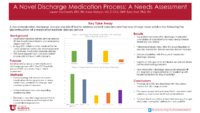 | A Novel Discharge Medication Process: A Needs Assessment | Mccreath, Lauren; Hobson, Alesa; Hart, Sara | 2024 | POSTER |
| 3 |
 | Assessing the Feasibility of the Use of the Critical-Care Pain Observation Tool Versus Non-Verbal Pain Scale in the Cardiovascular Intensive Care Unit and Surgical Intensive | Hunt, Sara | 2020 | Background: Accurate pain assessments in critically ill, mechanically ventilated patients can be difficult to obtain. The current pain assessment tool to assess pain in these patients at this medical facility is the Non-Verbal Pain Scale (NVPS). This pain scale uses vital sign variation as a compone... |
| 4 |
 | Changing Disinfecting Cap Protocol: A CLABSI Reduction Initiative | Watnes, Kelsey J.; Argyl, Jason; Nerges, John | 2024 | Central Line-Associated Bloodstream Infections (CLABSIs) cause an increased risk of mortality and cost to patients and hospitals. Short-staffing, non-compliance, and inadequate training are all possible contributing factors to an increase in CLABSIs. Antiseptic barrier caps are a possible preventati... |
| 5 |
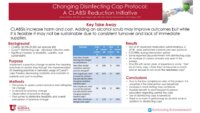 | Changing Disinfecting Cap Protocol: A CLABSI Reduction Initiative | Watnes, Kelsey J.; Argyl, Jason; Nerges, John | 2024 | POSTER |
| 6 |
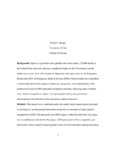 | Early Septicemia Recognition and Intervention Education for the Pre-Hospital Setting | Grange, Emily S. | 2020 | Background: Sepsis is a persistent issue globally and causes nearly 270,000 deaths in the United States each year, placing a significant burden on the US economy and the health care system. Over 40% of patients diagnosed with sepsis arrive at the Emergency Department (ED) via Emergency Medical Servi... |
| 7 |
 | Identifying and Addressing Barriers to Timely Admission from the Emergency Department to Medical/Surgical Floor | Dewey, Karen | 2020 | Background: Visits to Emergency Departments (ED) are increasing, which in turn increases the number of admissions from the ED to the inpatient medical/surgical floor. These increases have led to crowding in the ED, resulting in boarding of patients awaiting admission. Boarding in the ED has been lin... |
| 8 |
 | Implement a Standardized Anesthesia Order Set in the PACU | Bigman, Sadie J.; Dunn, Richard; Layman, Jennifer; Lufkin, James; Lynch, Keisa M. | 2024 | POSTER |
| 9 |
 | Implement a Standardized Anesthesia Order Set in the PACU | Bigman, Sadie J.; Dunn, Richard; Layman, Jennifer; Lufkin, James; Lynch, Keisa M. | 2024 | Incomplete physician orders are a significant cause of interdisciplinary miscommunication, patient treatment delays, inconsistent patient care, medication irregularities, and medication errors in the Post Anesthesia Care Unit (Kandaswamy et al., 2019; Park et al., 2018; Wells & Loshak, 2019). Commun... |
| 10 |
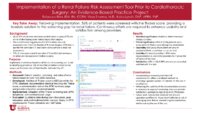 | Implementation of a Renal Failure Risk Assessment Tool Prior to Cardiothoracic Surgery: An Evidence-based Practice Project | Brim, Rebecca M.; Sharma, Vikas; Lynch, Keisa M. | 2024 | POSTER |
| 11 |
 | Implementation of a Renal Failure Risk Assessment Tool Prior to Cardiothoracic Surgery: An Evidence-based Practice Project | Brim, Rebecca M.; Sharma, Vikas; Lynch, Keisa M. | 2024 | Of patients undergoing cardiothoracic surgery (CTS), up to 50% are at risk of developing an acute kidney injury (AKI) after surgery (Zaouter et al., 2018). Acute kidney injury and renal failure can increase mortality and morbidity and lead to more extended hospital stays, longer ICU stays, and highe... |
| 12 |
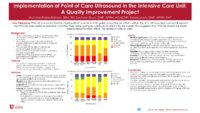 | Implementation of Point of Care Ultrasound in the Intensive Care Unit: A Quality Improvement Project | Edman, Nicholas B.; Drury, Zachary; Lynch, Keisa M. | 2024 | POSTER |
| 13 |
 | Implementation of Point of Care Ultrasound in the Intensive Care Unit: A Quality Improvement Project | Edman, Nicholas B.; Drury, Zachary; Lynch, Keisa M. | 2024 | Point of Care Ultrasound (POCUS) is the use of portable ultrasound technology by bedside clinicians for rapid patient assessment. POCUS has been found to decrease the time to accurate diagnosis and improve patient outcomes in the ICU (Yoshida et al., 2023). However, POCUS is underutilized within the... |
| 14 |
 | Implementation of the Surgical Safety Plan | Schelin, Jamee | 2020 | Background: The surgical setting is a high stressed environment where poor communication can lead to fatal errors. Medical errors cause between 44,000 and 98,000 deaths in the USA a year. The single biggest factor underlying these errors is poor communication between health professionals. A large he... |
| 15 |
 | Implementing a Sleep Wake Bundle in the ICU: A Quality Improvement Project | Smith, Phillip W.; Dalton, Anna; Hearne, Jenny; Allen, Nancy | 2024 | Poor sleep quality in the intensive care unit (ICU) can cause hormone imbalances, decreased energy, alterations in metabolic function, and impaired ventilation (Darby et al., 2022). Sleep disturbances can contribute to delirium and may lead to prolonged hospital lengths of stay, increased mortality,... |
| 16 |
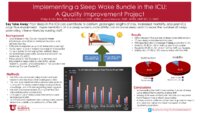 | Implementing a Sleep Wake Bundle in the ICU: A Quality Improvement Project | Smith, Phillip W.; Dalton, Anna; Hearne, Jenny; Allen, Nancy | 2024 | POSTER |
| 17 |
 | Implementing Early Mobility Guidelines in Medical Intensive Care Unit | Gu, Mingyu; Patterson, Scott W.; Christensen, Scott S. | 2024 | POSTER |
| 18 |
 | Implementing Early Mobility Guidelines in Medical Intensive Care Unit | Gu, Mingyu; Patterson, Scott W.; Christensen, Scott S. | 2024 | Patient early mobility has emerged as a safe and effective strategy to alleviate ICU-acquired weakness in critically ill individuals. Local Problem: In our local hospital's 25-bed Medical Intensive Care Unit (MICU), patients frequently experience sedation and prolonged bedrest, contributing to muscu... |
| 19 |
 | Implementing General Inpatient (GIP) Hospice Practice on an Acute Care Medical/Oncology Unit: An EBP Project | Hoch, Bonnie J.; Hauschildt, Marie; Palmer, Lisa; Randle, Meg; Halsey, Anna Marie; Christensen, Scott S. | 2024 | POSTER |
| 20 |
 | Implementing General Inpatient (GIP) Hospice Practice on an Acute Care Medical/Oncology Unit: An EBP Project | Hoch, Bonnie J.; Hauschildt, Marie; Palmer, Lisa; Randle, Meg; Halsey, Anna Marie; Christensen, Scott S. | 2024 | General Inpatient (GIP) Hospice services consist of pain and symptom management in the acute care setting, with high symptom burden requiring more intense management than can be offered at home. GIP hospice promotes better end-of-life (EOL) management and increases access to hospice services for rur... |
| 21 |
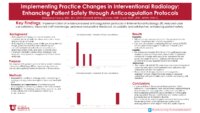 | Implementing Practice Changes in Interventional Radiology: Enhancing Patient Safety Through Anticoagulation Protocols | Young, Shaleena | 2024 | POSTER |
| 22 |
 | Implementing Practice Changes in Interventional Radiology: Enhancing Patient Safety Through Anticoagulation Protocols | Young, Shaleena | 2024 | Atrial Fibrillation (AF), Deep Venous Thrombus (DVT), and Pulmonary Embolus (PE) collectively affect millions, with AF alone impacting 3-5 million individuals (Polania et al., 2023). Annually, approximately 250,000 U.S. patients discontinue anticoagulation therapy for surgical procedures. Yet, Barne... |
| 23 |
 | Implementing Sedation Vacation, Spontaneous Breathing Trial, and Confusion Assessment Method in a Medical Intensive Care Unit | Bryden, Allyson | 2020 | Background: According to the Society of Critical Care Medicine, more than 5 million Americans are admitted to intensive care units (ICUs) annually. Of these admissions, 20%-40% require mechanical ventilation. Patients on mechanical ventilation usually receive continuous sedation medication. Such sed... |
| 24 |
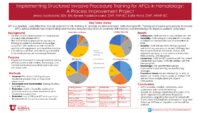 | Implementing Structured Invasive Procedure Training for APCs in Hematology: A Process Improvement Project | Mastroianni, Jenna; Vadeboncoeur, Renee; Ward, Katie | 2024 | POSTER |
| 25 |
 | Implementing Structured Invasive Procedure Training for APCs in Hematology: A Process Improvement Project | Mastroianni, Jenna; Vadeboncoeur, Renee; Ward, Katie | 2024 | Procedural training done "on-the-job" can lead to variable learning opportunities and patient outcomes. Inadequately trained providers who perform invasive procedures can negatively impact the cost of care and organizational liability. Institutions must take accountability for training advanced prac... |
